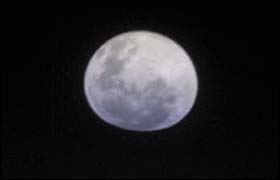The space station transmits images to Israel that illustrate unique sights of the whitewash
Dr. Noah Brosh

flat moon Photo from April 16 this year as the moon set on the horizon for the occupants of the International Space Station
Direct link to this page: https://www.hayadan.org.il/moonilusion0703.html
Photographs sent by the astronauts staying on the International Space Station demonstrate a multitude of phenomena related to light and show us our moon, from a different vantage point than usual - really unique sights, some of which are optical illusions or appear that way due to the influence of the composition of the atmosphere and the way it changes starting with its density, with the changes in altitude. (The images appear on the NASA website).
The Earth's atmosphere consists mainly of nitrogen molecules (about 80%) and oxygen (about 20%) and a small amount of other gases (carbon dioxide, water vapor, etc.). Yes, it contains "aerosols", particles larger than the molecules. These are tiny water droplets, dust grains and salt crystals, soot and industrial ash, and also meteor particles from space.
The density of the gas components of the atmosphere and their pressure change with height above the surface of the earth (or the sea): they decrease approximately 2.7 times every 8 km or so, in the range between 0 and 100 km altitude. The changes in aerosols are more acute. The same change occurs every 1 km or less - so the particles are more concentrated near the ground.
The atmosphere causes the refraction of light rays. A celestial gram near the horizon seems higher to us than it really is. As for the moon, its lower part, close to the horizon, appears higher than it really is. This part of the moon, higher than it should have been, for the moon to appear round. The white figure close to the horizon is flat.
Even when viewed from the space station, and the moon is close to the horizon (for the astronauts), its image appears flattened. Since the light rays pass through a thick atmospheric layer, they encounter a large amount of air molecules and aerosols. These cause a change in the visible color of the moon. Blue light is subtracted from it due to the color-dependent refraction of light. Because of this, the moon appears redder than usual, and the part closest to the horizon is even redder than the upper part.
Another image is of the moon floating in our atmosphere. This is an optical illusion caused by the proximity of the figure to the dark horizon, part of the night on Earth. This part of the horizon does not receive much radiation from the sun nor does it scatter much radiation towards the camera. The air is not "visible" - because in this state there is almost no illuminating contribution from it. Therefore, and because of the transparency of the upper layers of the atmosphere, it appears to the viewer as if the moon is closer than the edge of the figure of the earth.
All in all - an illusion, but beautiful!
For information on the NASA science website
https://www.hayadan.org.il/BuildaGate4/general2/data_card.php?Cat=~~~590334549~~~56&SiteName=hayadan
